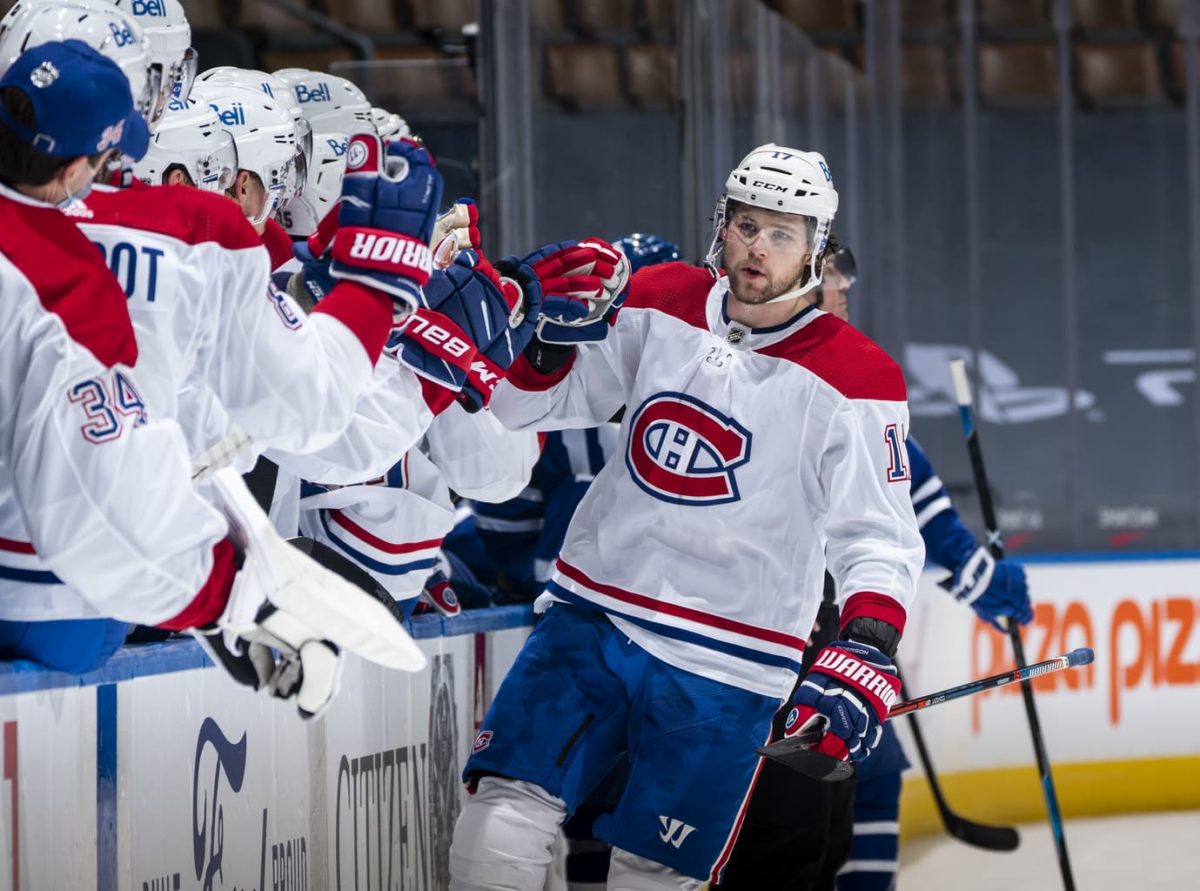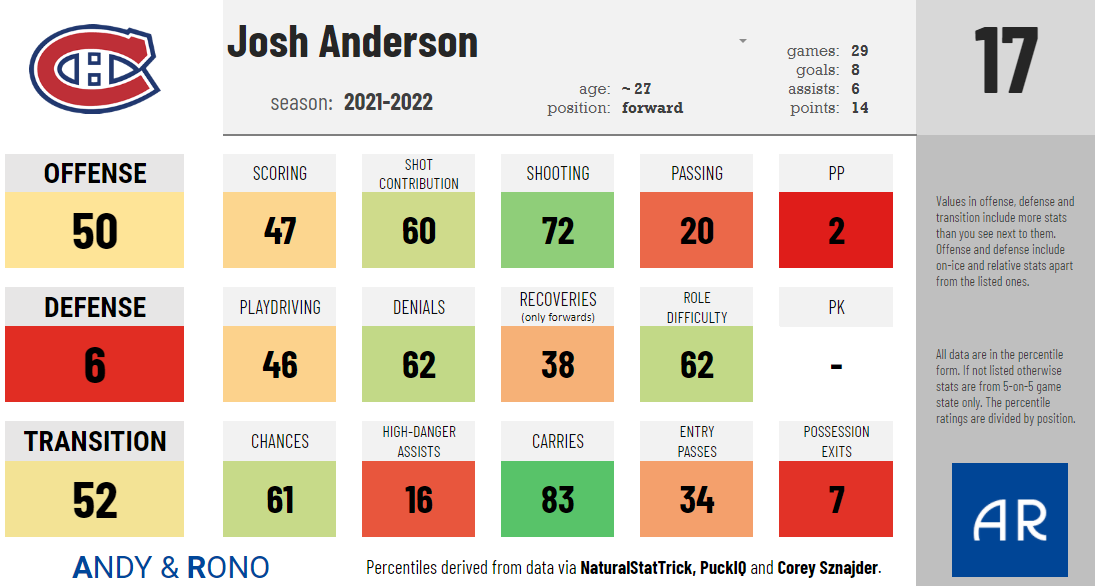Josh Anderson was acquired in a trade between the Montreal Canadiens and Columbus Blue Jackets back on Oct. 6, 2020. Since then, he has quickly become a fan favorite in La Belle Province, and for good reason. Anderson is a blue-collar hockey player — a hard worker not afraid to get his nose dirty or drop the gloves to defend a teammate. The 27-year-old is a power forward in every sense of the word. He will hit anything that moves, drive to the front of the net without hesitation, and be right in the middle of any scrum. Anderson’s old-school playstyle and desire to stay in Montreal make him hard not to like.
“Coming into Montreal on a long-term deal with a great team, I still believe that we can still do some pretty good things. Obviously, we’re in a tough situation right now. But I think that we have the right people to make this thing work. I love it here in Montreal. I signed a long-term deal…to stay in Montreal and to win here. So I’m honestly very excited with that. Like I said, I think they have the right people to make that happen.”
Josh Anderson on management changes in Montreal (from ‘Canadiens Notebook: Players look forward to getting to know new GM,’ Montreal Gazette, Jan. 20, 2022)
Anderson has a great attitude and clearly embraces the high-pressure environment in Montreal. However, there are aspects of his game that are concerning. With the Canadiens clearly out of the playoff picture, newly appointed general manager (GM) Kent Hughes needs to consider all options, and that includes exploring the appetite in the trade market for someone like Anderson. Here are some of the reasons why.
Anderson’s Contract
After trading Max Domi for Anderson, former GM Marc Bergevin signed No. 17 to a seven-year deal worth an average annual value (AAV) of $5.5 million. It was an odd move at the time and remains a head-scratching move today. Anderson was coming off a season where he registered four points in 26 games with the Blue Jackets. He had been dealing with injury problems throughout the year, but despite the injury concerns, Bergevin felt he needed to lock down Anderson until 2027. The former GM was no stranger to signing mid-to-low impact players to multi-year contracts (Joel Armia), and Anderson benefited from his generosity.

Hughes has no attachment to any of these players. The new Canadiens GM is coming in with a fresh and objective perspective. Looking at Anderson, the Ontario native does not come close to warranting his contract. According to Dom Luszczyszyn’s NHL Player Cards — cards developed to measure a player’s overall impact and market value using three seasons of data — Anderson’s contract should fall around $2 million AAV given his on-ice impact (from ‘NHL Player Cards: Montreal Canadiens,’ The Athletic, Jan. 24, 2022). In other words, he is making more than double what he should be making annually. A bad deal, if ever there was one. And the Canadiens’ roster is ridden with deals similar to Anderson’s.
In today’s salary cap era, contracts like these are contending killers. Players wind up in roles well above their skill level and inevitably get exposed. In Anderson’s case, he is an effective third- or fourth-line player. He can hit and make plays in transition. He stands up for his teammates. But he’s not a player that will produce consistent offense every night. He can’t even be relied on in difficult defensive situations. These are all things needed out of a top-six forward; things the Canadiens are not getting from Anderson on a regular basis.
Related: Canadiens Would Benefit From Trading Artturi Lehkonen
Anderson’s impact aligns with that of a bottom-six forward, but he is paid like he belongs in the top six. Players under bargain contracts, like Tyler Toffoli and Artturi Lehkonen, have been thrown around in trade talks, making it all the more puzzling why overpaid players are not being talked about more. While it’s true it is more difficult to find suitors for players with bad contracts, those options need to be explored first before considering the alternative (ridding the few good contracts the team has left).
But how can the Canadiens entice a team to trade for Anderson? Let’s dive into the pros and cons of No. 17’s game.
Anderson’s Pros & Cons
Anderson is a bonafide power forward. He has good speed for his size, drives the net in transition, and plays a physical brand of hockey. He also doesn’t need to be asked twice to defend a teammate, putting that on full display Monday night when he went after Minnesota Wild defenseman Jared Spurgeon for his blindside hit on Christian Dvorak. These are all selling points that can be used to trade Anderson. He can diversify a lineup with his size and speed and adds a physical element that has historically been valued in the playoffs.

Anderson is a puck carrier. He works well with teammates who successfully retrieve and move pucks out of the defensive zone at high rates. In transition, the neutral zone is where Anderson thrives. His signature move is to drive to the outside and beat defensemen with his speed, creating scoring chances in tight. Anderson is not going to wow with his playmaking ability, nor will he shut down the opposition’s best players. In fact, the 27-year-old struggles with zone exits and gets hemmed in the defensive zone frequently. This is why it is crucial for Anderson to play with teammates who transition well from the defensive zone to other areas of the ice. The Canadiens do not have enough players like that to complement No. 17.
The Ontario native’s playstyle is not well suited for the power play either, as evidenced by him being in the 2nd percentile of the league. He is not a good passer or playmaker, important skills to have on the man advantage. In the last three seasons, Anderson has averaged 1.16 points per 60 minutes on the power play (per Natural Stat Trick). Over the same timeframe, he has averaged 1.71 points per 60 minutes at even strength. In other words, since the 2019-20 season, Anderson has produced at a higher rate at even strength than on the power play. To put that in perspective, most players double or even triple their offensive production rates on the power play vs even strength. Anderson doesn’t even match his production at even strength. It begs the question of why he is on the power play in the first place, but that is a story for another time.
Anderson can be helpful to a contender. He adds diversity to a lineup teams look for come playoff time. While he does need a specific type of environment to flourish, that does not mean he can’t be useful for the right team. Newly appointed GM Hughes was left with very few decent contracts. Bad long-term contracts are one of the main reasons teams stay bad. While there are hurdles in trading unideal contracts, not even entertaining the idea would be a mistake. No stone should be left unturned, and some stones should be turned over first. Trading Anderson is one of them.
